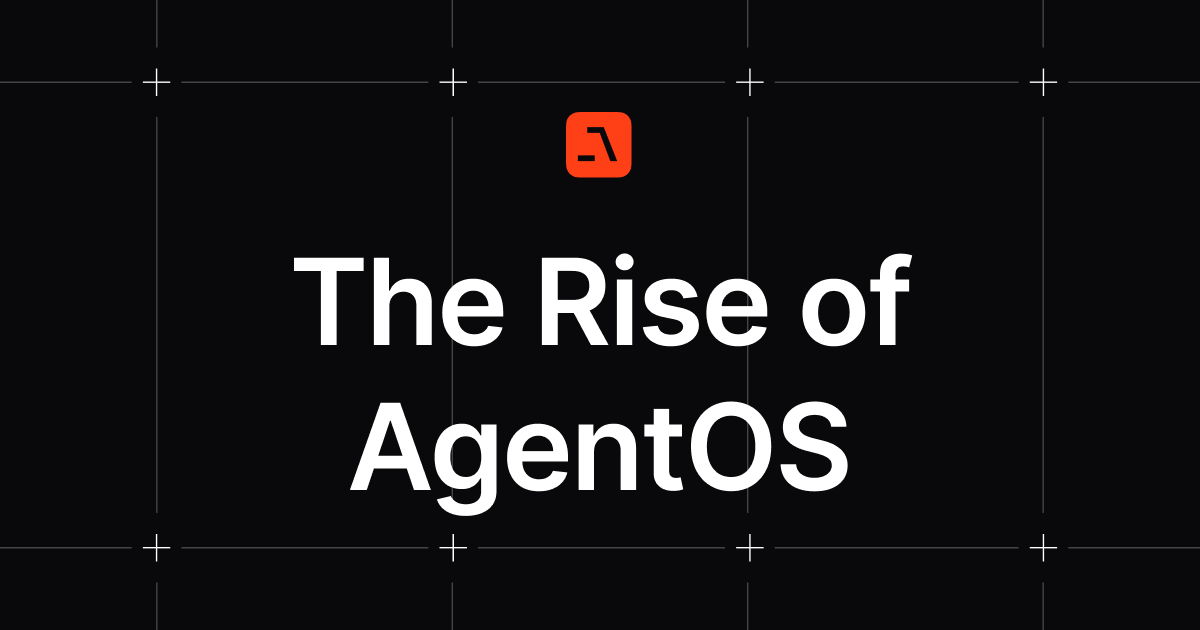Every company runs on an invisible operating system: a network of people, knowledge, processes, and software working together to move the business forward. This human OS has long powered every decision, workflow, and outcome.
But we’re now starting to see the sparks of something new.
Beneath the surface of today’s organizations, a parallel operating system is starting to rise—one powered not by people alone, but by intelligent agents.
This agent operating system connects a network of autonomous and semi-autonomous agents with shared memory, shared context, and access to an ever-expanding universe of tools through the Model Context Protocol (MCP). It forms the foundation of a new digital workforce, but not one that’s built to replace humans. It’s one built to work alongside them—accelerating creativity, execution, and scale.
Just as cloud infrastructure transformed how companies build software, the Agent OS will transform how companies operate. We’re entering a new era where humans and agents collaborate natively, and organizations evolve into intelligent, adaptive systems.
It’s a future where every person, business, and government commands a network of intelligent agents that automate the mundane and free us for more creative, meaningful pursuits.
It’s a future that we are incredibly excited about, and one that we are actively helping to shape. We’re leading the charge in defining what an Agent Operating System can be and developing the infrastructure that makes it real. Our goal is to give every organization the foundation to build, deploy, and scale intelligent multi-agent systems with the same confidence and reliability they expect from their core systems today.
This moment marks a fundamental shift in how technology and people work together, and we’re proud to be at the forefront, driving the research, engineering, and innovation that will make this future possible.
Redefining how work gets done
The Human Operating System
Every company, whether it realizes it or not, runs on an invisible operating system. It’s the sum of its people, processes, and technology. It’s the systems that coordinate how decisions are made, how knowledge flows, and how work gets done. This human OS is what keeps organizations functioning day to day and connects vision to execution.
For decades, this operating system has been refined through new tools and frameworks: project management platforms, CRMs, ERPs, collaboration software, etc. Each innovation has helped humans organize complexity, communicate faster, and make better decisions. But despite all this progress, the core operating system remains human-powered. That means it’s reliant on our time, our attention, and our ability to turn information into action.
That model has taken us far. But it’s also reaching its limits. The sheer scale, speed, and complexity of modern organizations now demand something more—something that can extend human capability, not just organize it.
The Agent Operating System
If the Human Operating System is powered by people and their tools, the Agent Operating System (AgentOS) is powered by intelligent agents—digital counterparts that can perceive context, reason, communicate, and act across a company’s systems and data.
AgentOS is the infrastructure layer that allows these agents to operate cohesively. It manages shared memory, context, and communication, giving agents a common understanding of the organization’s goals and environment. Instead of isolated bots performing narrow tasks, the AgentOS enables a network of agents to collaborate, delegate, and learn from each other—much like a team of people would.
The future belongs to the agent-native enterprise
Today, organizations are built on human coordination. Teams communicate, delegate, and decide. Tools help streamline that process, but they still depend on people to connect the dots. The result is that human attention becomes the ultimate bottleneck.
The AgentOS changes that equation. By introducing intelligent agents that can understand goals, retain context, and act autonomously, it allows organizations to move faster and operate at a new level of scale. Repetitive and time-consuming work can be handled automatically, while humans stay focused on strategy, creativity, and complex problem-solving.
This isn't just another incremental improvement in user interface design. AgentOS represents a complete reimagining of the relationship between humans and machines, promising to transform our computers from tools we operate into collaborative partners that truly understand and anticipate our needs.
The future is one where every organization runs on an AgentOS, and every employee has a multi-agent system working alongside them—their agentic twin, if you will. These personal AI counterparts will amplify human ability to unprecedented levels.
AgentOS is the next step beyond organized human labor, unlocking extended capability and impact to truly expand what individuals (and organizations) can achieve.
From experimentation to essential infrastructure
It’s a future that’s arriving fast. The past year has been defined by experimentation—spinning up single agents, testing isolated workflows, and exploring what’s possible. The next era is about turning those experiments into infrastructure.
We are now entering a phase where intelligent systems aren’t side projects or prototypes but core components of enterprise operations. As this shift accelerates, enterprises will evolve from being AI-enabled to becoming agent-native. Agent-native organizations will operate on a foundation of continuous intelligence. They won’t just execute tasks, they’ll understand objectives, adapt to change, and collaborate fluidly across departments. These systems will enable humans to focus higher in the value stack—on creativity, strategy, and innovation—while the agent infrastructure handles coordination, monitoring, and optimization behind the scenes.
In this new paradigm, the companies that thrive will be those that re-architect around intelligence, not just automation. AgentOS represents the shift from stand-alone apps to systems that think, from one-off use cases to organization-wide intelligence. The enterprises that embrace this early won’t simply move faster—they’ll evolve faster, building adaptive, self-learning operations that define the next decade of progress.
Acknowledgements
This post was written by Ashpreet Bedi, Agno’s CEO, and Cosette Cressler, content marketing lead.


